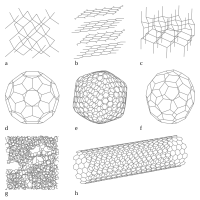
Photo from wikipedia
The effect of spin—orbit coupling on the electron levels of (5, 3), (8, 7), (11, 3), (18, 11), (10, 5), (8, 8), and (13, 0) gold nanotubes of various diameters… Click to show full abstract
The effect of spin—orbit coupling on the electron levels of (5, 3), (8, 7), (11, 3), (18, 11), (10, 5), (8, 8), and (13, 0) gold nanotubes of various diameters and chirality was studied in the framework of the relativistic version of the linear augmented cylindrical wave method. Spin-dependent band structures and electron state densities were calculated. Spin—orbit coupling is manifested as splitting of nonrelativistic dispersion curves. For the dispersion curve that crosses the Fermi level in the (5, 3) tube of the minimum radius, this splitting reaches 0.5 eV and decreases on going to low-lying valence band states. An increase in the radius and a decrease in the cylindrical surface curvature of these nanotubes suppress the spin—orbit splitting. All tubes possess a metal type band structure in which the number of conduction channels increases with increasing radius of the nanotube.
Journal Title: Russian Journal of Inorganic Chemistry
Year Published: 2019
Link to full text (if available)
Share on Social Media: Sign Up to like & get
recommendations!